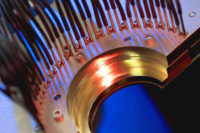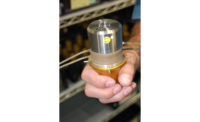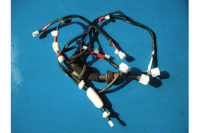“In the past, spin welding was considered a very crude process,” admits Bill Reed, director of marketing at Extol Inc.
Today, sensors, servomotors and microprocessors give assemblers tremendous control over the process. Engineers can program speed, acceleration, deceleration, force, displacement, weld time and hold time. They can tell the welder when to start spinning and when to stop. They can even program the welder to stop rotating the part at a specific point, so features on the top part can be accurately positioned relative to features on the bottom part.
Thanks to these improvements, spin welders are seeing use in a wide range of industries, including automotive, appliance, medical and consumer goods. The technique produces strong welds with any thermoplastic, including crystalline materials, like polypropylene, and soft materials, like Santoprene. Spin welding can join parts as small as 0.5 inch in diameter or as large as 18 inches in diameter.
How It Works
At first glance, a spin welder could easily be mistaken for an ultrasonic welder. Like an ultrasonic welder, a spin welder is a tabletop machine with a vertically mounted linear actuator perpendicular to a tooling base.
The linear actuator can be a pneumatic cylinder or a servo-driven ballscrew. A pneumatic cylinder is adequate for the vast majority of applications, while a servo-driven linear axis is best for more difficult or exacting applications. With a servo axis, “You can precisely control the vertical speed of the ram and ensure constant thrust during the weld cycle,” says Miranda Marcus, applications engineer at Dukane Corp.
The drive head—the mechanism that rotates the part—is attached to the end of the ram. It can be powered by an air motor and flywheel (so-called inertia welders), a direct-drive electric motor with dynamic braking, or a servomotor.
With an inertia welder, the drive head must be loaded with the mating part, or it must engage the part while rotating. It is not possible for the drive head to contact the part before rotation begins.
At the start of the cycle, the air motor begins rotating the drive head. When the target speed is reached, the air supply to the motor is shut off, and the drive head descends. Inertia from the flywheel keeps the drive head spinning.
When the part halves are pressed together, friction generates enough heat to melt the plastic. Friction also acts as a brake on the flywheel, eventually stopping it. By that time, molten material from each part has mixed together and formed a weld. Pressure is then maintained on the parts for a short time to allow the plastic to solidify.
Depending on the application, parts less than 6 inches in diameter can be spin welded in 0.5 to 2 seconds, excluding time for loading and unloading the parts.
The process works much the same way if the drive head is powered directly by an electric motor. The only difference is that a brake—not friction from the parts—stops the drive head. Compared with an air motor, an electric motor provides more torque, which is critical for welding large parts, and greater control over the process.
“You want to maintain speed and torque throughout the weld process,” says Mark Caldwell, national sales manager at Sonics & Materials Inc. “You can’t do that with an air motor.”
Using an electric motor also enables the drive head to contact the top part before rotation begins. The drive head can come down, pick up the part, rise up, start spinning, and come back down again to make the weld. That can be useful for integrating the spin welder with a rotary indexing table or pallet transfer conveyor in an automated assembly system.
Alternatively, it can contact the top part and then begin spinning. That can be important for applications in which the top part captures an internal part, like a spring, or applications in which part fit-up is an issue, explains Reed. Another advantage of the static start is that the welder can more easily verify the overall height of the assembly prior to welding as a quality control check.
If an electric motor is better than an air motor, a servomotor provides ultimate control over the drive head. A servomotor can maintain a specific speed for the duration of the weld. The drive head can be triggered to start spinning as soon as the parts touch, and then weld to a specific collapse distance. And, a servomotor can stop the part at a specific point, often to within ±1 degree. That can be important for aligning decorative features on the parts or ensuring that an input nozzle points in the same direction every time.
Key Parameters
The key parameters of the spin welding process are rotation speed, force, time and displacement.
Speed and force vary with the size and composition of the parts, says Eric Kuzniar, applications engineer at Branson Ultrasonics Corp. With a servomotor welder, speed can range from 250 to 5,000 rpm. An inertia welder can reach speeds of 10,000 rpm.
Although it may seem counterintuitive, larger diameter parts need less speed than smaller ones, says Kuzniar. Indeed, for large-part applications, the electric motor might be equipped with a gear reducer to swap speed for torque.
“You have to think in terms of surface feet per minute, rather than rotations per minute,” explains Reed. “The optimal surface feet per minute setting for nylon is different from ABS or polypropylene. We don’t see many applications over 5,000 rpm, and 1,000 to 2,000 rpm is a pretty typical range.”
Force is usually minimal. “The more pressure you apply when bringing the parts together, the more the assembly wants to resist torque,” says Caldwell. “If you rub the palms of your hands together lightly, they’ll get hot pretty quick. Squeeze them together hard, and it’s difficult to move your palms back and forth.”
Weld and hold times can also be important. “I’ve seen huge improvements in weld quality just by changing the hold parameters,” says Marcus. “Because you are melting a large amount of material, it’s important to control how it melts. Usually, you want to collapse the parts while they are melting, because plastic shrinks as it solidifies. You have to make sure you don’t have any voids in the parts.”
Part Design
Spin welding can join any thermoplastic, whether filled or unfilled, amorphous or semicrystalline, says Reed. Spin welders can join ABS, PVC, polypropylene, polyethylene and glass-filled nylon, to name a few. They have difficulty with slippery plastics, such as Delrin or ultra-high-molecular-weight polyethylene.
“If you have very hard parts, like polycarbonate or acetal, it can take a lot of torque to get the materials to start melting,” warns Marcus. “Generally, it’s easier to spin-weld larger parts made from softer materials than harder materials.”
Spin welding can even weld dissimilar materials. “The parts don’t have to be as chemically similar as they do with ultrasonic welding,” says Marcus. “In terms of material compatibility, spin welding is more like vibration welding. I’ve seen a spin-welded joint that was polyethylene to polypropylene. It was a mechanical joint with a hermetic seal that could hold a pressure of 30 psi—something you would never see with ultrasonic welding.”
Spin welding can join some plastic parts that other methods cannot. For example, tall parts represent “far-field welds” for ultrasonic welders, but they’re no problem for spin welders. Similarly, spin welding can accommodate parts with contours, openings or extensions that would otherwise pose tooling challenges for ultrasonic or vibration welders.
The one requirement for spin welding is that the joint interface must be circular, though the parts themselves do not have to be round.
Spin welding melts and moves more material than other plastic joining methods—as much as three times more. That makes the technology ideal for creating pressure-resistant, hermetically sealed joints. Marcus’ lab has produced a spin-welded joint that could hold a pressure of 100 psi.
However, more melted material means more flash, and engineers will have to account for that in their joint designs.
“The key with spin welding is to visualize where the flash is going to go and how to hide it,” says Caldwell. “Because of centrifugal force, the flash typically wants to move outside the joint.”
| For more information on appliance assembly, check out these articles: |
| Plastics Assembly: Good Vibrations |
| Assembly in Action: Plastic Welders Take to the Sea |
| Metal vs. Plastic Ultrasonic Welding |
The best designs for spin welding are shear joints, tongue-and-groove joints, and scarf joints. Butt joints can also be accomplished, but they’re rare.
“For the best weld strength, best performance and least amount of torque draw, you should always use a shear joint,” says Marcus. “If you know your molds aren’t great, if you have some warpage on your parts, or if you’re not sure the parts will fit together consistently, that’s when you want to use a scarf joint.”
A shear joint consists of two walls that contact each other at an angle with an interference fit, says Reed. Shear joints can be designed with flash traps to capture excess molten plastic. A skirt can also be designed into the top part to hide the joint line for a more cosmetic appearance.
Due to the “active” nature of the process, it’s a good idea to include a feature—a rib or a recess—to help the drive head spin the top half and aid the fixture in holding the bottom half. Sometimes, the drive head can key on a port, fitting or other feature sticking out from the part, if the feature is robust enough.
For extra grip, the drive head and fixture can also be modified with spring-loaded ball detents, a Flexane coating, or vacuum ports.
To prevent deflection, the tooling should also support the sides of the assembly, irrespective of how thick the walls are, says Reed. Softer plastics are easy to melt, but are also prone to deflection.
Regardless of the application, engineers are well-advised to contact welding equipment suppliers as early in the design process as possible—preferably before any molds are cut. “An application engineer can help you work through drive features and joint design features,” says Kuzniar. “It becomes a collaborative process. There’s always back and forth between the customer’s design constraints and the ideal joint design.”
Applications
Spin welding is used in a wide range of applications. It’s used to weld insulated cups and bowls; filters for water and chemicals; plumbing floats; paint can lids; pop-up irrigation valves; and line splitters for juice and soda dispensers.
In the automotive industry, spin welders assemble tanks, bottles, valves, lamps and filters. The technique is also used to install small elbows into manifolds and to weld extruded tubing to molded attachments for fuel filter lines.
Extol recently worked on an automotive application that involved welding a hose made from Santoprene, to an air intake made from polypropylene. Welding the hose eliminated the need for a pricey, circular steel clamp to attach the hose.
In the appliance industry, spin welding has been used to assemble valves, flow diverters, vacuum cleaner housings and water filters for refrigerators.
Spin welding can also be used to assemble medical devices. Extol recently designed a machine to weld talc-filled polypropylene for a fluid recovery device. Each half of the assembly was 10 inches long and 3 inches in diameter. “There were very few other process options,” Reed points out. “Vibration welding couldn’t do it, because we wouldn’t be able to address flash control on the inside. Spin welding was a great solution.”
For medical applications, it’s important to note that spin welding can generate particulates. However, vacuum or compressed air can be used to clear particulates during assembly, adds Marcus.











